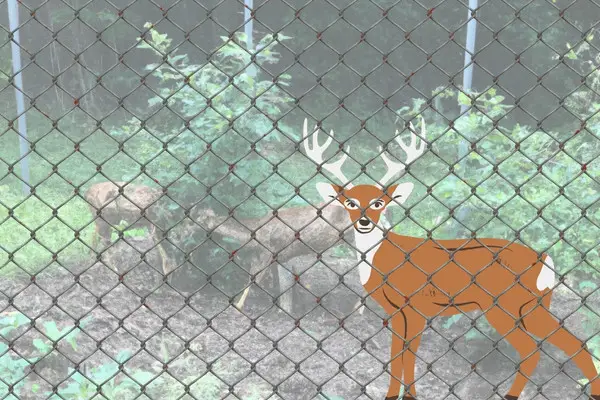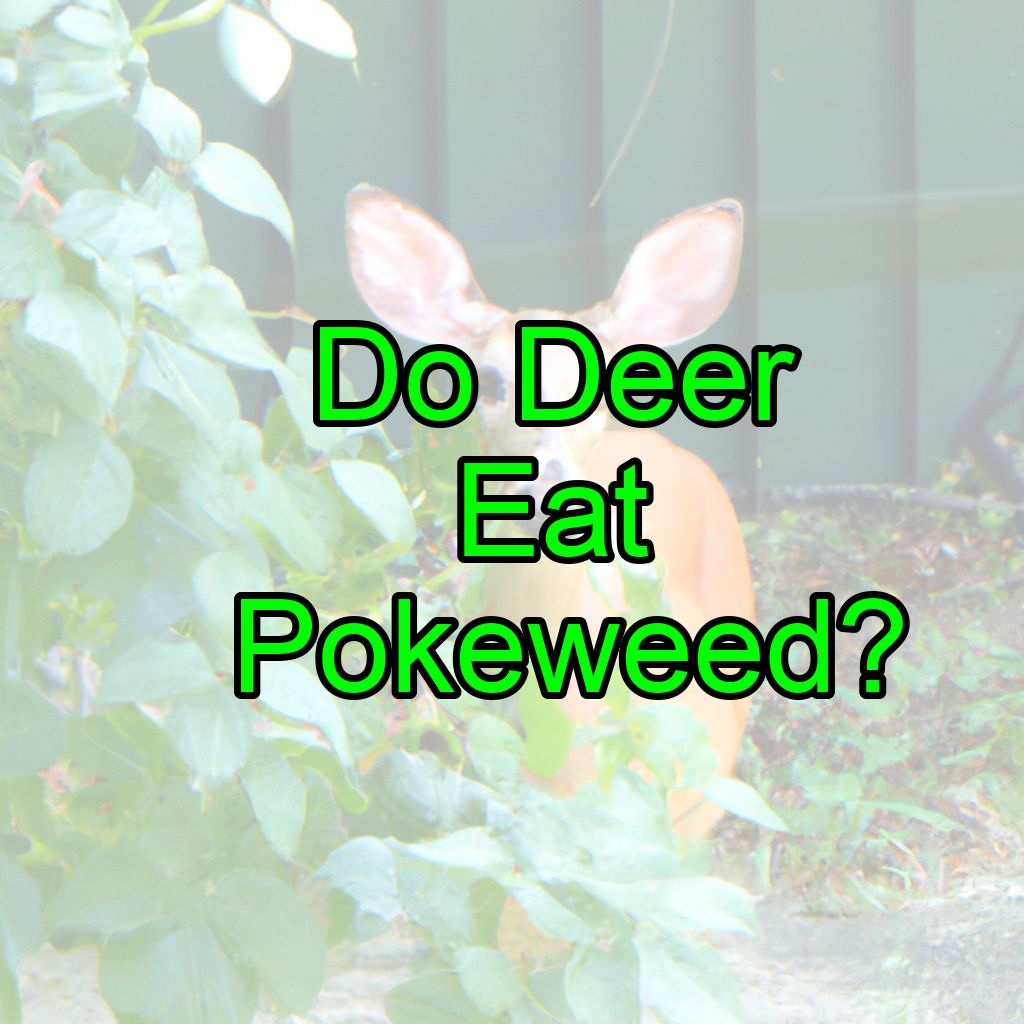As a backyard owner, I am always curious about the dietary choices of the various wildlife that frequent my garden. Deer are a common sight in my area, and their grazing habits have often led me to wonder what they will and won’t eat.
One question that has piqued my curiosity is, “do deer eat pokeweed?” After doing some research, I found that deer do eat pokeweed, but the frequency and reasons for this can vary.
In this blog post, I will explore the factors that influence when, how, and why deer eat pokeweed, and what this means for backyard owners like myself.
Contents
What is Pokeweed?
Pokeweed (Phytolacca americana) is a perennial plant native to North America. It is commonly found in pastures, along roadsides, and in disturbed areas. The plant can grow up to 10 feet tall and features large, green leaves and clusters of dark purple berries. While pokeweed has been used in traditional medicine and as a food source for humans, it is important to note that all parts of the plant can be toxic if not prepared correctly.
When Do Deer Eat Pokeweed?
Deer are known to be opportunistic feeders, meaning they will eat a wide variety of plants depending on the season and availability.
They are more likely to eat pokeweed during the spring and summer months when the plant is actively growing and producing new leaves and stems. During this time, the plant is more tender and palatable, making it an attractive option for deer.
How Do Deer Eat Pokeweed?
Deer have a unique feeding strategy called “browsing,” which involves taking small bites from a variety of plants. This allows them to sample different types of vegetation and select the most nutritious options.
When deer encounter pokeweed, they will typically nibble on the leaves and stems and occasionally consume the berries.
How Often Do Deer Eat Pokeweed?
The frequency with which deer eat pokeweed can vary depending on several factors, such as the availability of other food sources and the size of the deer population in a given area.
In areas with an abundance of alternative food options, deer may only eat pokeweed occasionally. However, in areas where food is scarce or there is a high density of deer, they may consume pokeweed more frequently.
Why Do Deer Eat Pokeweed?
Despite the potential toxicity of pokeweed, deer eat the plant because it provides some nutritional benefits. Pokeweed is high in protein and essential minerals like calcium, magnesium, and potassium.
These nutrients are particularly important for deer during the spring and summer months when they are growing and need to replenish their energy reserves.
Can Deer Tolerate Pokeweed’s Toxicity?
While all parts of the pokeweed plant contain toxic compounds, deer have a remarkable ability to tolerate these toxins. This is because their digestive system is designed to break down plant material and neutralize some of the harmful substances found in pokeweed.
However, it is important to note that consumption of large quantities of pokeweed can still pose a risk to deer, particularly if they are already in poor health or are experiencing stress from other factors such as drought or predation.
Implications for Backyard Owners
As a backyard owner, it is essential to be aware of the potential dangers that pokeweed can pose to both humans and wildlife like deer. While deer can tolerate the toxins in pokeweed to some extent, it is still important to monitor their consumption of the plant and be mindful of the potential risks.
Additionally, it is crucial to educate yourself and others about the proper handling and preparation of pokeweed if you choose to use it as a food source or for medicinal purposes.
Other Animals That Eat Pokeweed
Deer are not the only animals that consume pokeweed. Other wildlife species, such as birds, rabbits, and raccoons, have been known to eat the plant. Birds, in particular, play an essential role in the dispersal of pokeweed seeds, as they consume the berries and spread the seeds through their droppings.
How Do I Protect My Yard From Deer?
There are several ways to prevent pests like deer from invading your backyard. I will go through my favorite methods here.
Many of these methods overlap with those used to deter groundhogs and gophers from a backyard, but the exact products and prioritized recommendations are different.
1. Motion-activated sprinklers
Like most animals, deer hate surprises, and they will run away if suddenly sprayed with water. I like this solution because it is humane, simple, effective, and does not require much time to set up and there are many models to choose from.
The Havahart 5277 is a motion-activated sprinkler that is activated by the movement of animals up to 25 feet away and sprays them with a harmless water jet, frightening them off and keeping them at bay.
The included metal stake makes it easy to install in your backyard, and the sprinkler can be rotated 180 degrees for maximum coverage.
These sprayers work particularly well for larger animals as they are easier to target and detect. They are also less prone to smaller stimuli but a splash of cold water is quite a substantial impact to them!
2. Ultrasonic Sound Emitters
Deer, as well as other animals that may invade your backyard, tend to have very good hearing. This means that loud or consistent noises will scare them away or at least shorten their visits significantly!
One of my favorite technologies to keep pests away from my backyard is these cool solar-powered ultrasonic sound emitters that you can buy right from Amazon!
In my experience, they really work, and the solar panels on top save you the time and money of changing batteries all the time.
3. Using Lights and Reflections
Deer are most active at dawn and dusk so they may avoid areas that have bright lights. Motion-activated lights, sounds, and sprinklers may help prevent deer from entering your yard.
Placing CDs or tin foil and mirrors around your yard is another cheap and effective way to create light reflections that blind and scare deer away from your tomatoes.
This may sound a little old-fashioned but it still works! The reflective surface of CDs or tin foil drives deer crazy and will make them seek away from your plants.
You can use old CDs you no longer need or aluminum trays from takeaway containers, just make sure they reflect light well.
If you have a lot of plants to protect this way, it may be a good idea to invest in some commercial mirrors or electronic light emitters like the ones shown above.
4. Build a Fence
The most obvious and practical solution to protecting your plants from deer is to install a fence around the patch. A fence should be at least 6 feet tall and sunk in the ground about 8 inches.

The best fencing material for this purpose is a cattle panel or hog panel as they are very sturdy and can withstand even quadruped animals such as goats, cows, and deer.
However, most chicken fencing types will do. This will be strong enough to stop them from getting through while still allowing for airflow and sunlight.
If you don’t like the idea of building a fence around your entire onion patch then you can try fencing off only the area that your onions, tomatoes, or zucchinis are in; this will at least keep some of the deer, groundhogs or gophers away from them.
5. Using Hot Pepper Or Garlic Spray
This is a good way to protect your vegetable plants or decorative flowers against pests such as gophers, rabbits, groundhogs, and deer. It will also protect your backyard against the neighbor’s cat that thinks it is fine to use your vegetable garden as a toilet.
You only need about 1 tablespoon of crushed chili pepper and garlic along with 1 cup of vinegar per half a gallon of water.
Spray this mixture on any exposed parts of the plant until completely covered. Make sure you reapply whenever rain washes away the spray.
6. Use Deer Deterring Companion Plants
Instead of making a tincture out of strongly smelling plants, you can also just plant the plants themselves!
Companion planting is a good way of deterring animals like deer from your garden. You can plant strong-smelling plants such as garlic, basil, lavender, and chives around your favorite vegetables.
These plants will keep animals like deer, gophers, and mice away because they don’t like the smell of these and they mask the smell of the delicious plants.
7. Use Deer Repellents
You can use some of the commercially available repellents to protect your vegetable plants against deer, gophers, and other animals eating your tomatoes.
You will need to be careful when using these though because some of them can end up harming you and your pets if not applied properly. Some of the commercial deer repellents available include Shake-Away, Bonide Repels All, Critter Ridder, and Tom Cate Repellent.
Green Screen is my favorite one as it comes in small bags that you place around your tomato plants. It is safe and easy to use with all edible plants in your garden!
Watch how Farmer Dean uses the Green Screen repellent to keep away deer from his tomatoes in this video:
Conclusion
In conclusion, deer do eat pokeweed, but the frequency and reasons for this can vary. Understanding the factors that influence their consumption of the plant, as well as the potential risks associated with pokeweed, is essential for backyard owners and wildlife enthusiasts alike. By being aware of these factors, we can better appreciate and coexist with the fascinating wildlife that shares our environment.



















